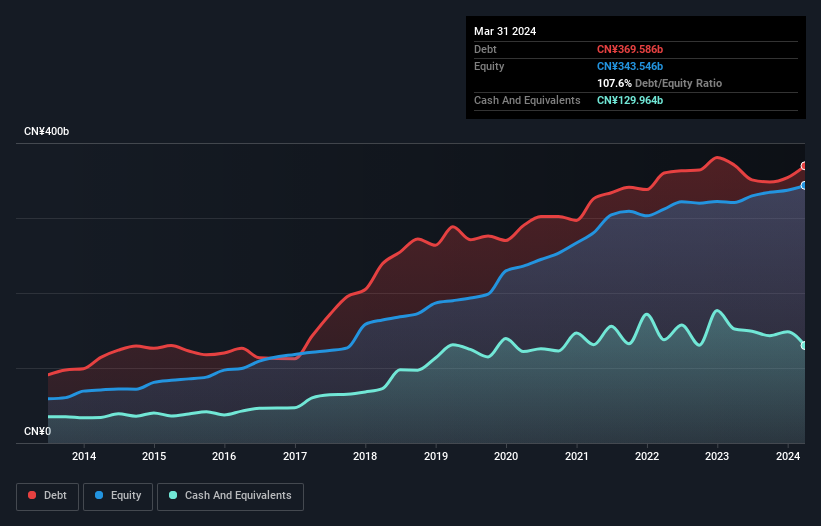- China
- /
- Real Estate
- /
- SHSE:600048
Is Poly Developments and Holdings Group (SHSE:600048) A Risky Investment?

Legendary fund manager Li Lu (who Charlie Munger backed) once said, 'The biggest investment risk is not the volatility of prices, but whether you will suffer a permanent loss of capital.' It's only natural to consider a company's balance sheet when you examine how risky it is, since debt is often involved when a business collapses. Importantly, Poly Developments and Holdings Group Co., Ltd. (SHSE:600048) does carry debt. But is this debt a concern to shareholders?
When Is Debt A Problem?
Debt is a tool to help businesses grow, but if a business is incapable of paying off its lenders, then it exists at their mercy. If things get really bad, the lenders can take control of the business. However, a more frequent (but still costly) occurrence is where a company must issue shares at bargain-basement prices, permanently diluting shareholders, just to shore up its balance sheet. Of course, debt can be an important tool in businesses, particularly capital heavy businesses. The first thing to do when considering how much debt a business uses is to look at its cash and debt together.
View our latest analysis for Poly Developments and Holdings Group
How Much Debt Does Poly Developments and Holdings Group Carry?
As you can see below, Poly Developments and Holdings Group had CN¥369.6b of debt, at March 2024, which is about the same as the year before. You can click the chart for greater detail. However, because it has a cash reserve of CN¥130.0b, its net debt is less, at about CN¥239.6b.

A Look At Poly Developments and Holdings Group's Liabilities
Zooming in on the latest balance sheet data, we can see that Poly Developments and Holdings Group had liabilities of CN¥770.7b due within 12 months and liabilities of CN¥310.1b due beyond that. Offsetting these obligations, it had cash of CN¥130.0b as well as receivables valued at CN¥160.7b due within 12 months. So its liabilities total CN¥790.1b more than the combination of its cash and short-term receivables.
This deficit casts a shadow over the CN¥118.7b company, like a colossus towering over mere mortals. So we'd watch its balance sheet closely, without a doubt. After all, Poly Developments and Holdings Group would likely require a major re-capitalisation if it had to pay its creditors today.
We use two main ratios to inform us about debt levels relative to earnings. The first is net debt divided by earnings before interest, tax, depreciation, and amortization (EBITDA), while the second is how many times its earnings before interest and tax (EBIT) covers its interest expense (or its interest cover, for short). This way, we consider both the absolute quantum of the debt, as well as the interest rates paid on it.
Strangely Poly Developments and Holdings Group has a sky high EBITDA ratio of 8.4, implying high debt, but a strong interest coverage of 22.9. So either it has access to very cheap long term debt or that interest expense is going to grow! Shareholders should be aware that Poly Developments and Holdings Group's EBIT was down 22% last year. If that decline continues then paying off debt will be harder than selling foie gras at a vegan convention. When analysing debt levels, the balance sheet is the obvious place to start. But ultimately the future profitability of the business will decide if Poly Developments and Holdings Group can strengthen its balance sheet over time. So if you want to see what the professionals think, you might find this free report on analyst profit forecasts to be interesting.
Finally, a business needs free cash flow to pay off debt; accounting profits just don't cut it. So we always check how much of that EBIT is translated into free cash flow. Looking at the most recent three years, Poly Developments and Holdings Group recorded free cash flow of 25% of its EBIT, which is weaker than we'd expect. That's not great, when it comes to paying down debt.
Our View
To be frank both Poly Developments and Holdings Group's EBIT growth rate and its track record of staying on top of its total liabilities make us rather uncomfortable with its debt levels. But at least it's pretty decent at covering its interest expense with its EBIT; that's encouraging. After considering the datapoints discussed, we think Poly Developments and Holdings Group has too much debt. While some investors love that sort of risky play, it's certainly not our cup of tea. The balance sheet is clearly the area to focus on when you are analysing debt. But ultimately, every company can contain risks that exist outside of the balance sheet. These risks can be hard to spot. Every company has them, and we've spotted 3 warning signs for Poly Developments and Holdings Group (of which 1 makes us a bit uncomfortable!) you should know about.
If you're interested in investing in businesses that can grow profits without the burden of debt, then check out this free list of growing businesses that have net cash on the balance sheet.
New: Manage All Your Stock Portfolios in One Place
We've created the ultimate portfolio companion for stock investors, and it's free.
• Connect an unlimited number of Portfolios and see your total in one currency
• Be alerted to new Warning Signs or Risks via email or mobile
• Track the Fair Value of your stocks
Have feedback on this article? Concerned about the content? Get in touch with us directly. Alternatively, email editorial-team (at) simplywallst.com.
This article by Simply Wall St is general in nature. We provide commentary based on historical data and analyst forecasts only using an unbiased methodology and our articles are not intended to be financial advice. It does not constitute a recommendation to buy or sell any stock, and does not take account of your objectives, or your financial situation. We aim to bring you long-term focused analysis driven by fundamental data. Note that our analysis may not factor in the latest price-sensitive company announcements or qualitative material. Simply Wall St has no position in any stocks mentioned.
Have feedback on this article? Concerned about the content? Get in touch with us directly. Alternatively, email editorial-team@simplywallst.com
About SHSE:600048
Poly Developments and Holdings Group
Poly Developments and Holdings Group Co., Ltd.
Established dividend payer with adequate balance sheet.
Similar Companies
Market Insights
Community Narratives



